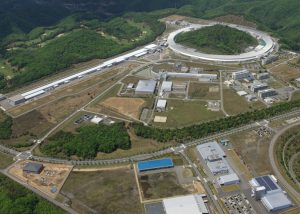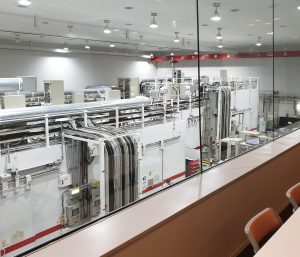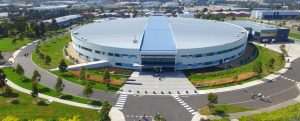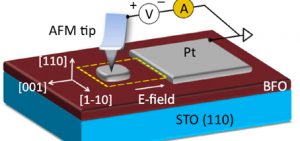- UNSW PhD student focuses one-km long laser to probe electronic structure
- Measuring femto-second responses on X-ray Free Electron Laser (XFEL)
- One of the highest energies of any synchrotron in the world.
“It’s a pretty surreal being at the pointy end of almost a kilometre-long laser,” says UNSW PhD student Oliver Paull.
“Not because of any danger from the laser (even though it’s several trillions times brighter than the Sun), but because of the responsibility…”
Oliver Paull (UNSW School of Material Science and Engineering) was in Japan last month using cutting-edge, worlds-best ‘XFEL’ facilities to measure the ultra-fast optical response in a complex thin-film structure.
It’s a significant responsibility for a PhD student, as Oliver’s measurement required the entire laser facility to be ‘aimed’ at his sample material – focused on a target area only 50 thousandths of a millimetre across.
“The difference between a XFEL and other similar facilities is that at a synchrotron, say, you can have over 50 different experiments operating more-or-less at the same time,” says Oliver. “But with an XFEL, the entire (almost) one-kilometre long facility, plus all the staff, are operating for one set of scientists at the business end of the laser – which was us!”
The Spring-8 XFEL: a one-kilometre long laser
The SPring-8 centre, near Osaka in Japan, has the highest energy electrons of any synchrotron facility in the world, and has approximately 50 beamlines in operation to study systems ranging from biology, magnetism, quantum dynamics, and medical imaging.
The Spring-8 facility also includes an X-ray Free Electron laser (XFEL): a relatively new form of imaging technology that provides a light source that is extremely intense, very tightly focused, and can pulse on and off incredibly quickly.
In an XFEL, free electrons are accelerated to velocities approaching the speed of light, then ‘wiggled’ by powerful, applied magnetic fields to travel in a sinusoidal path. As the electrons are oscillated, they emit powerful radiation which itself interacts with the electrons and produces a laser effect (a process called self-amplified spontaneous emission).
An XFEL creates an extremely intense x-ray beam focused to an extremely small spot size (just 50 microns across), with laser pulse widths that are femto-seconds long (ie, millionths of a billionth of a second in duration).
The SACLA XFEL is one-billion times more brilliant than the adjacent Spring-8 synchrotron, can focus its beam to a spot one-thousandth as wide, and has a pulse width one-thousand times shorter.
This extreme brightness of the XFEL would destroy some samples with a single XFEL pulse.
The SACLA XFEL is the first beamline of its kind to produce laser X-rays with a wavelength below 0.1 nm.
XFEL technology is still in its infancy and SACLA is still a very new facility, designed to allow for future upgrades to accommodate the many scientific fields that can benefit from this experimental technique.
Why students stand in front of lasers
The experiment delivers a ‘movie’ showing the physical distortion in the sample before and after the optical laser pulse on the femto-second scale.
“This allows us to accurately determine exactly how our sample gets distorted when it is optically excited,” says Oliver.
“The reason why this complicated experiment is interesting/useful to us is because our samples are also extremely complicated.”
The material being analysed is the single-only known material that hosts magnetic and electrical ordering (a so-called multiferroic) at room temperature – Bismuth Ferrite (BFO). The sample in question is host to two coexisting phases of BFO that have their own respective free energies, all competing and contributing to the microstructure and the system’s large electro-mechanical properties.
“Using SPring-8, we can see how these phases compete with one another on a femto-second time scale,” says Oliver.
The research follows on from work by Paul Evans (University of Wisconsin-Madison) and his team, who have performed many experiments using a pulsed ultraviolet laser to optically excite a crystal structure, and subsequently measuring the response by the XFEL using conventional x-ray diffraction.
“The most important aspect of the experiment is (1) making sure there is spatial overlap between the optical and X-ray laser (i.e. you’re measuring the part of the crystal that is optically excited), and (2) making sure you accurately know the overlap in time (so-called ‘time zero’).”
“Once you know this,” says Oliver “you can change the path-length of the optical laser in order to measure the time delay between the optical laser exciting the crystal and the XFEL measuring the excitation.”
Through extensive analysis and simulations, Paul Evans and Nagy’s group will be able to unpack these energy terms (which have until now only been approximated with no direct verification) as well as the dynamics of this system.
“This will help steer the direction of research in this system towards more functional devices,” says Oliver.
Oliver works with Nagarajan (‘Nagy’) Valanoor: a Chief Investigator at FLEET, and a Professor at UNSW’s School of Materials Science and Engineering. His team explores oxides and thin-film materials as a platform for new, low-energy topological devices. Nagy’s team also synthesises many of the ferroelectric and ferromagnetic heterostructures, and novel topological oxides, used by other FLEET researchers seeking low-energy transistors.
FLEET (The Centre for Future Low-Energy Electronics Technologies) is an Australian Research Council Centre of Excellence bringing together over a hundred researchers, seeking to develop ultra-low energy electronics to face the challenge of energy use in computation, which already consumes 8% of global electricity, and is doubling each decade.
More information
- Contact Oliver Paull o.paull@unsw.edu.au
- Contact Nagy Valanoor nagarajan@unsw.edu.au
- Visit FLEET.org.au
- Connect @FLEETCentre








